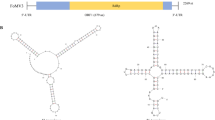Abstract
Tomato ringspot virus (ToRSV) has been detected in Chile, causing economically important diseases in a wide range of hosts. A ToRSV isolate was obtained from raspberry cv Heritage (Rasp-CL) showing leaf yellowing and stunting. The complete genome of Rasp-CL was sequenced by deep sequencing. The Rasp-CL RNA1 sequence shared 97.4 % nucleotide sequence identity with divergent RNA1 of isolate Rasp1-2014, while Rasp-CL RNA2 showed high divergence from all four isolates available in the database, sharing only 63.9-72.7 % nucleotide sequence identity. This difference was mainly based on the X4 coding region, which has been reported to be a high-variability region. Moreover, based on differences in the X4 region, three Rasp-CL RNA2 variants of different length were identified in the same host. One putative recombination event was identified between the Rasp-CL and GYV-2014 X4 genes. Phylogenetic analysis suggested that ToRSV isolates with currently available sequences form three distinct groups. Our results suggest that, for an accurate phylogenetic classification of ToRSV, it is necessary to obtain sequences of both RNAs. This is the first report of a complete ToRSV genome sequence from South America.

Similar content being viewed by others
References
Auger J, Converse RH (1982) Raspberry bushy dwarf and Tomato ringspot viruses in Chilean red raspberries. In: R Stace-Smith (ed). Acta Hortic 3rd International Symposium on Small Fruit Diseases 9–10
Medina C, Matus JT, Zúñiga M, San Martín C, Arce Johnson P (2006) Occurrence and distribution of viruses in commercial plantings of Rubus, Ribes and Vaccinium species in Chile. Ciencia e investigación agraria: revista latinoamericana de ciencias de la agricultura 33:23–28
Rojas M, Sepúlveda G (2006) Monitoreo de las principales enfermedades virales que afectan al cultivo de tomate en el Valle de Azapa, I región Chile. XVI congreso nacional de fitopatología. Centro Regional de Investigación Intihuasi, La Serena Chile
Reyes E, Valladares P, Cornejo C, Betanzo R, Muñoz C, Sandoval C (2006) Determinación de la presencia de Tomato Ringspot Nepovirus ToRSV en huertos de arándano, manzano y frambueso de la VII región de Chile. XVI congreso nacional de fitopatología. Centro Regional de Investigación Intihuasi, La Serena Chile
Auger J (1989) Tomato ringspot virus (TomRSV) associated with brownline disease on prune trees in Chile. Acta Hortic 235:197–204
Herrera MG (1996) Panorama virológico en frutales de carozo, pomáceas y vides en la zona central de Chile. Simiente 66:35–36
Herrera MG, Madariaga M (2002) Incidencia de Prunus necrotic ringspot virus (PNRSV), Prune dwarf virus (PDV), Tomato ringspot virus (ToRSV) y Plum pox virus (PPV) en viveros frutales de carozo de la zona central de Chile. Agric téc 62:38–45
Smith KM, (1972) A textbook of plant virus diseases (edition 3) Longman, London, pp 541-544
Sanfaçon H, Wellink J, Le Gall O, Karasev A, Van der Vlugt R, Wetzel T (2009) Secoviridae: a proposed family of plant viruses within the order Picornavirales that combines the families Sequiviridae and Comoviridae, the unassigned genera Cheravirus and Sadwavirus, and the proposed genus Torradovirus. Arch Virol 154:899–907
Rott ME, Gilchrist A, Lee L, Rochon D (1995) Nucleotide sequence of Tomato ringspot virus RNA1. J Gen Virol 76:465–473
Han S, SanfaÇon H (2003) Tomato ringspot virus proteins containing the nucleoside triphosphate binding domain are transmembrane proteins that associate with the endoplasmic reticulum and cofractionate with replication complexes. J Virol 77:523–534
Rott ME, Tremaine JH, Rochon DM (1991) Nucleotide sequence of Tomato ringspot virus RNA-2. J Gen Virol 72:1505–1514
Rott ME, Tremaine JH, Rochon DM (1991) Comparison of the 5′ and 3′ termini of Tomato ringspot virus RNA1 and RNA2: evidence for RNA recombination. Virol 185:468–472
Walker M, Chisholm J, Wei T, Ghoshal B, Saeed H, Rott M, Sanfaçon H (2014) Complete genome sequence of three Tomato ringspot virus isolates: evidence for reassortment and recombination. Arch Virol 160:543–547. doi:10.1007/s00705-014-2240y
Hughes DW, Galau G (1988) Preparation of RNA from cotton leaves and pollen, Plant Molec. Biology Reporter 6:253–257
Griesbach JA (1995) Detection of Tomato ringspot virus by polymerase chain reaction. Plant Dis 79:1054–1056
Fuchs M, Abawi G, Marsella-Herrick P, Cox R, Cox KD, Carroll JE, Martin RR (2010) Occurrence of Tomato ringspot virus and Tobacco ringspot virus in highbush blueberry in New York State. J Plant Pathol 92:451–459
Damsteegt VD, Waterworth HE, Mink GI, Howell WE, Levy L (1997) Prunus tomentosa as a diagnostic host for detection of Plum pox virus and other Prunus viruses. Plant Dis 81:329–332
Hall TA (1999) BioEdit: a user-friendly biological sequence alignment editor and analysis program for Windows 95/98/NT. Nucl Acids Symp Ser 41:95–98
Tamura K, Stecher G, Peterson D, Filipski A, Kumar S (2013) MEGA6: Molecular Evolutionary Genetics Analysis version 6.0. Mol Biol and Evol 30:2725–2729
Jafarpour B, Sanfacon H (2009) Insertion of large amino acid repeats and point mutations contribute to a high degree of sequence diversity in the X4 protein of Tomato ringspot virus (genus Nepovirus). Arch Virol 154:1713–1717
Martin DP, Lemey P, Lott M, Moulton V, Posada D, Lefeuvre P (2010) RDP3: a flexible and fast computer program for analysing recombination. Bioinformatics 26:2462–2463
Stewart EL, Qu XS, Overton BE, Gildow FE, Wenner NG, Grove DS (2007) Development of a real-time RT-PCR SYBR Green assay for Tomato ring spot virus in grape. Plant Dis 91:1083–1088
Acknowledgments
This work was supported by a Chilean scholarship program for graduate students (Scholarship Number 21100336) from the National Commission for Scientific and Technological Research, CONICYT, Chile.
Author information
Authors and Affiliations
Corresponding author
Electronic supplementary material
Below is the link to the electronic supplementary material.
Rights and permissions
About this article
Cite this article
Rivera, L., Zamorano, A. & Fiore, N. Genetic divergence of tomato ringspot virus. Arch Virol 161, 1395–1399 (2016). https://doi.org/10.1007/s00705-016-2775-1
Received:
Accepted:
Published:
Issue Date:
DOI: https://doi.org/10.1007/s00705-016-2775-1




